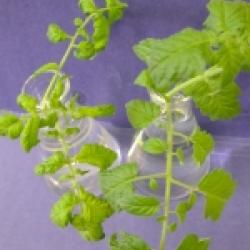Source Institutions
Source Institutions
Add to list Go to activity
Activity link broken? See if it's at the internet archive

In this four-part laboratory exercise, learners investigate properties of Tobacco mosaic virus (TMV) including (1) symptoms induced by the virus in susceptible plants at the macroscopic and microscopic levels, (2) its stability at high temperatures, and (3) its small size. Learners first propagate tomato and pinto bean plants, and then inoculate their dried leaves with TMV. Learners observe the TMV-infected leaves as well as use a heat treatment to inactivate the virus. Learners also filter the infected sap with a bacteria-proof filter to investigate size. This lesson guide includes background information, tips for educators, and discussion questions with answers. Adult supervision is recommended. Note: The Tobacco mosaic virus is available from biological suppliers, but approval for shipping of the virus across state lines must be obtained from the USDA prior to shipment.
- 1 to 4 weeks
- 1 to 7 days
- Over $20 per group of students
- Ages 14 - 18
- Activity, Experiment/Lab Activity, Lesson/Lesson Plan
- English
Quick Guide
Materials List (per group of students)
- Tomato (Lycospersicon esculentum) seeds
- Pinto bean (Phaseolus vulgaris 'Pinto bean') seeds
- Potting mix, pots and trays
- TMV in living/dried tissue or in frozen sap from infected tissue (See Teacher Tips for methods for long term storage of the virus.)
- Tap water, if the pH is neutral, or 0.05 M phosophate buffer, pH 7. The buffer can be made by adding 0.6 gm of sodium phosphate dibasic (Na2HPO4) and 6.4 gm sodium phosphate monobasic (Na2HPO4) to a total volume of 1 liter.
- Mortars and pestles (must be sterilized after use-See Teacher Tips)
- Systemic host (tomato) or local-lesion host (pinto bean), depending on the experiment
- Mild abrasive-celite (diatomaceous earth) or carborundum (See Teacher Tips for cautions using these abrasives.)
- Cheesecloth pieces or cotton swabs
- Plant labels and markers
- Scissors
- Slide containing cross sections of TMV-infected and healthy leaves
- Compound microscope (100X and 400X)
- Water or 0.05 M phosphate, pH 7, buffer for grinding tissue
- Cheesecloth for straining tissue and for inoculating leaves
- Water baths or hot plates, 500-ml beakers, and thermometers. A range of temperatures from room temperature to boiling should be tested. For example, four temperatures: 25, 50, 75, and 100°C could be used. If water baths are not available, water can be heated in beakers placed on hot plates.
- Test tubes, holders, and rack
- Ice
- Pinto beans--the assay host (See sections on Propagating plants and Inoculating plants)
- Pot labels
- Clinical centrifuge
- Transfer pipettes, 2 per preparation
- Micron filters (pore size 220 nm or 0.22 µm) with Luer-lock fitting for attachment onto a syringe
- Syringe (5- or 10-ml) with a Luer-lock fitting
- Marker
Subjects
-
Life Sciences
- Cells
-
Diversity of Life
- Plants
- Viruses and Bacteria
-
The Nature of Science
-
The Scientific Process
- Conducting Investigations
- Gathering Data
- Formulating Explanations
- Communicating Results
-
The Scientific Process
Informal Categories
- Food and Cooking
- Gardening
- Nature and Environment
Audience
To use this activity, learners need to:
- see
- see color
- read
- touch
Learning styles supported:
- Involves hands-on or lab activities
Other
Components that are part of this resource:
- Purpose and Background Information
- Materials and Methods
- Lesson Plan
- Supplemental Information and References
This resource is part of:
Access Rights:
- Free access
By:
- Ford, Rosemary ; Evans, Tom
Rights:
- All rights reserved, The American Phytopathological Society, 2011
